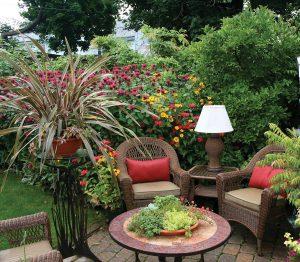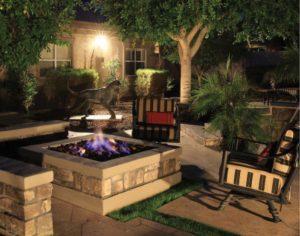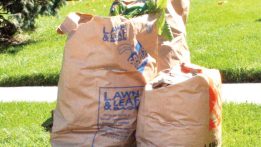 The best way to make the most of the space in your backyard is to be intentional about your design. Have a plan for what you want your yard to look like, and deliberately arrange your items to meet your design goal. Here are some ideas to help make your yard seem more spacious and inviting.
The best way to make the most of the space in your backyard is to be intentional about your design. Have a plan for what you want your yard to look like, and deliberately arrange your items to meet your design goal. Here are some ideas to help make your yard seem more spacious and inviting.
Think Vertically
With limited square footage, use the vertical space available. Draw the eye up to distract from the small area. Vertical gardens can be a beautiful way to add character to your yard and add some greenery to your yard without taking up too much room on the ground. If you would like to plant trees, go with trees that grow up instead of out to help save space. High structures, such as trellises, pergolas or arbors, are also great ways to maximize your vertical space. Make sure your high structures are as tall as or taller than your doorways in order to provide enough room to comfortably walk under them and avoid making your yard seem smaller rather than larger.
Designate Areas
Dividing your yard into specific areas can help maximize the space you have and help your yard feel less crowded. If your kids’ toys are scattered among the vegetable garden or your gardening tools end up on your outdoor dining set, your yard likely seems too small and busy. Having designated areas gives each space its own boundaries. Simply arranging furniture in specific places will help define your areas, or you can use different ground materials to designate the areas of your yard and provide clear boundaries.
Use Levels and Tiers
You can combine the ideas of maximizing your vertical space and designating areas by using levels and tiers. Dividing your yard into different levels helps make it seem more spacious and larger than it is. By raising or lowering your patio even a few steps, you can create two or more distinct places and add dimension to your yard. You can also add dimension by adding a raised planter or container garden or by placing your plants on a tiered platform.
Design Diagonal Patterns and Winding Paths
Diagonal patterns elongate a space. If you’re building a deck, consider laying the planks diagonally as opposed to vertically or horizontally to make it seem larger. For walkways, opt for a winding path cutting diagonally through your yard rather than a straight one. You can also make your walkway an optical illusion by gradually decreasing the walkway’s width as it moves toward the back of the yard; this will make it appear longer than it actually is. These small changes trick your eyes and help make your small space seem larger.
Define Your Yard as a Destination
Give your backyard a purpose, and turn it into a destination. Design it to be somewhere you want to spend time, and its size will not matter. Whether you make it the home for a grill and the place to host cookouts or you design your own outdoor reading or game area, designing your backyard to be a place you want to go will make your time spent there more enjoyable. A small yard with no purpose is useless. Instead of allowing your yard to be an empty space, put something in it. Although adding something large may seem to make your yard smaller, it may make it more useful and help make the most of the space it has.
Focus on a Focal Point
 Draw the eye to something specific and away from the size of the yard. Whether you have a fountain, sculpture, fire pit, garden, or outdoor dining set, make something the center of attention. By focusing on the center of the yard, you can trick your eyes into seeing the space as bigger than it actually is. Having something to focus on also helps add character and dimension to your yard.
Draw the eye to something specific and away from the size of the yard. Whether you have a fountain, sculpture, fire pit, garden, or outdoor dining set, make something the center of attention. By focusing on the center of the yard, you can trick your eyes into seeing the space as bigger than it actually is. Having something to focus on also helps add character and dimension to your yard.
Design Cohesively
By implementing the same type of design style from the inside of your house in the yard, you connect the two spaces. An indoor room that opens up and extends into the backyard makes both areas seem larger. Even when your backyard is its own separate area, matching the same style as the inside of the house helps you and others see the two areas as a cohesive unit. Adding your design style to your backyard will also help you feel more inclined to use the space.
Use Colors Purposefully
You can use color to draw attention to or from certain areas. By placing warm colors at the front of the yard closest to the house, it draws people’s attention to the house instead of to the back of the yard. Cool, natural colors placed toward the back can help it blend into the natural surroundings and make the boundary seem less severe, and, thus, the yard seems bigger. Bright colors near your focal point will draw attention to it, and your color scheme can also help tie in your design style.
Be Particular with Plants
Along with color, you can use plants to draw attention as well as add dimension. Plants with big leaves help add texture to your yard, and the shadows created by their leaves also add depth. Because several small plants in a small area can feel crowded, for a tight space, consider planting a few larger plants around the yard.
Simplify
Keep your design simple to avoid it looking cluttered and crowded. Use clean lines and clear boundaries. With some open space, the features of your yard that are most important to you will stand out. ![]()
Kimberly McMahon
Home & Yard Magazine




